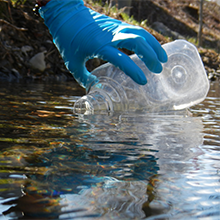Department Aquatic Ecology
Application of environmental DNA (eDNA) in biomonitoring
The species compositions of riverine ecosystems are currently rapidly changing or declining, and we critically depend on reliable and timely information on the occurrence of species. Such information is a prerequisite for the conservation of threatened species, the management of keystone species or as an early-warning tool for the arrival of non-native species. Information on species occurrences and biodiversity, however, is assembled through a variety of methods, often measured at low intervals, and is generally not very sensitive for species at low densities. This is problematic for two reasons. First, the lack of standardised methods across taxa is reducing the generality of the findings. Second, the lack of sensitivity to populations at low densities is missing an important aspect of diversity, especially as these populations are often of overproportionate interest, such as of rare species or non-native species at the onset of an invasion. The use of environmental DNA (eDNA) may overcome some of these limitations. All organisms constantly shed DNA (e.g., skin particles, mucous, feces) into the environment, referred to as eDNA. Environmental DNA is a novel technology, offering a promising tool both for the monitoring of rare species as well as for the early detection of non-native species. Novel next generation sequencing techniques allow the detection of DNA sequences even at very low amounts, and through the use of existing barcoding databases, the sequences can be used to identify the occurrence of organisms ranging from bacteria, to plants and animals. We are developing tools and protocols on how to use eDNA in the context of biodiversity monitoring in riverine ecosystems. Thereby, we are especially interested in its application at the catchment scale, and the identification of organisms across all domains of life. We study the origin, transport and fate of eDNA, and its possible use for understanding community composition and dispersal of organisms within riverine networks.

